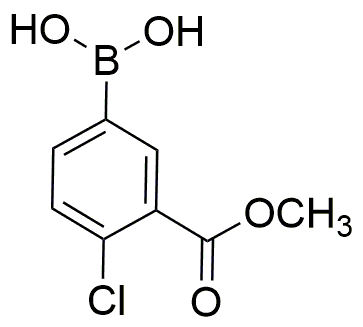4-Chloro-3-(methoxycarbonyl)phenylboronic acid is widely utilized in research focused on:
- Pharmaceutical Development: This compound is instrumental in the synthesis of various pharmaceuticals, particularly in the development of targeted cancer therapies due to its ability to form stable complexes with biologically relevant molecules.
- Organic Synthesis: It serves as a key intermediate in organic synthesis, allowing chemists to create complex molecules efficiently. Its unique structure enables the formation of diverse chemical bonds, enhancing synthetic pathways.
- Material Science: In the field of material science, it is used to modify polymer properties, improving their mechanical strength and thermal stability, which is essential for developing advanced materials.
- Bioconjugation: The compound is valuable in bioconjugation processes, where it helps attach biomolecules to surfaces or other molecules, facilitating the development of biosensors and diagnostic tools.
- Environmental Chemistry: It plays a role in environmental applications, such as the detection and removal of pollutants, by forming complexes with harmful substances, thus aiding in environmental remediation efforts.
General Information
Properties
Safety and Regulations
Applications
4-Chloro-3-(methoxycarbonyl)phenylboronic acid is widely utilized in research focused on:
- Pharmaceutical Development: This compound is instrumental in the synthesis of various pharmaceuticals, particularly in the development of targeted cancer therapies due to its ability to form stable complexes with biologically relevant molecules.
- Organic Synthesis: It serves as a key intermediate in organic synthesis, allowing chemists to create complex molecules efficiently. Its unique structure enables the formation of diverse chemical bonds, enhancing synthetic pathways.
- Material Science: In the field of material science, it is used to modify polymer properties, improving their mechanical strength and thermal stability, which is essential for developing advanced materials.
- Bioconjugation: The compound is valuable in bioconjugation processes, where it helps attach biomolecules to surfaces or other molecules, facilitating the development of biosensors and diagnostic tools.
- Environmental Chemistry: It plays a role in environmental applications, such as the detection and removal of pollutants, by forming complexes with harmful substances, thus aiding in environmental remediation efforts.
Documents
Safety Data Sheets (SDS)
The SDS provides comprehensive safety information on handling, storage, and disposal of the product.
Product Specification (PS)
The PS provides a comprehensive breakdown of the product’s properties, including chemical composition, physical state, purity, and storage requirements. It also details acceptable quality ranges and the product's intended applications.
Certificates of Analysis (COA)
Search for Certificates of Analysis (COA) by entering the products Lot Number. Lot and Batch Numbers can be found on a product’s label following the words ‘Lot’ or ‘Batch’.
*Catalog Number
*Lot Number
Certificates Of Origin (COO)
This COO confirms the country where the product was manufactured, and also details the materials and components used in it and whether it is derived from natural, synthetic, or other specific sources. This certificate may be required for customs, trade, and regulatory compliance.
*Catalog Number
*Lot Number
Safety Data Sheets (SDS)
The SDS provides comprehensive safety information on handling, storage, and disposal of the product.
DownloadProduct Specification (PS)
The PS provides a comprehensive breakdown of the product’s properties, including chemical composition, physical state, purity, and storage requirements. It also details acceptable quality ranges and the product's intended applications.
DownloadCertificates of Analysis (COA)
Search for Certificates of Analysis (COA) by entering the products Lot Number. Lot and Batch Numbers can be found on a product’s label following the words ‘Lot’ or ‘Batch’.
*Catalog Number
*Lot Number
Certificates Of Origin (COO)
This COO confirms the country where the product was manufactured, and also details the materials and components used in it and whether it is derived from natural, synthetic, or other specific sources. This certificate may be required for customs, trade, and regulatory compliance.


